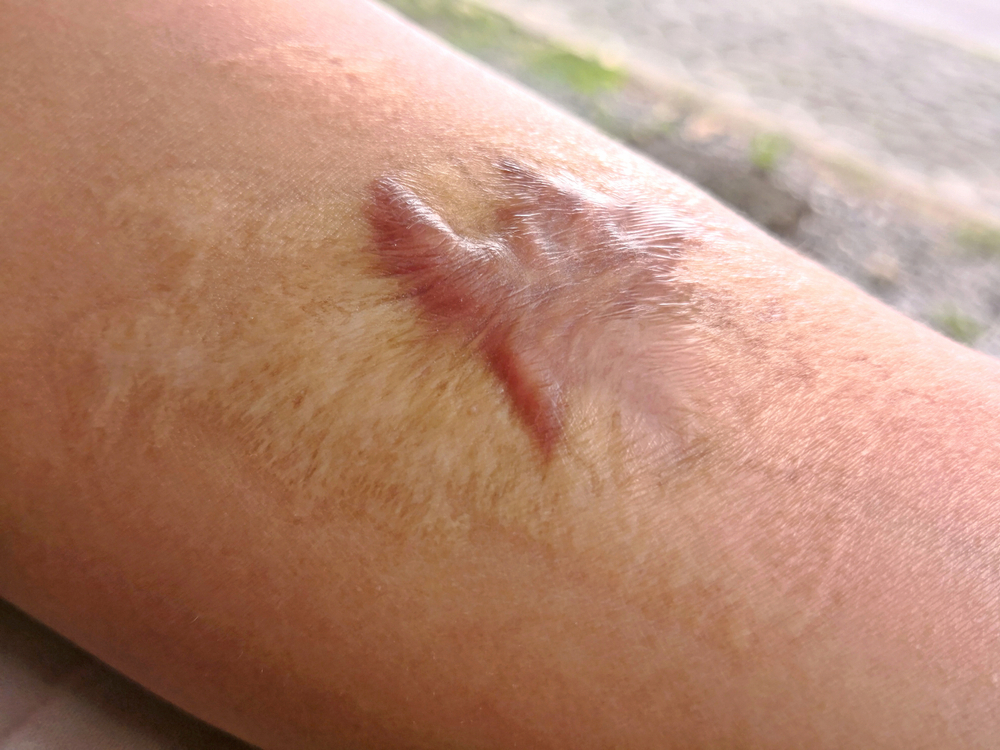It can happen to the best of us. A bump against the table, a scrape on the pavement, or a run-in with a curling iron. These minor mishaps all have something in common: they can injure the skin. But don't panic. By using the right skin injury treatment, you can support your skin's natural healing process and get back to a luminous, healthy complexion. Read on to learn all about skin care for scars, burns, and dark spots.
How Do Common Injuries Affect the Skin?
Skin injuries are fairly common, but different types can affect your skin in different ways. You're probably most familiar with the bruises that result from bumping into things. Fortunately, bruises don't require any special treatment other than time.
But other skin injuries can be more likely to cause infection or leave permanent, sometimes even disfiguring, scars. If you cut your skin—whether it's a scrape, gash, or burn—it has the potential to leave a scar if it's deep enough to involve the dermis (the middle skin layer).
Types of Scars
Scars are your body's way of healing and replacing damaged skin by forming new collagen fibers to repair a skin wound, whether from a burn, procedure, or accident. These fibers are thicker and less flexible than normal skin, so they stand out. They can vary in color and shape, and they may appear flat, depressed, or raised.
If you have melanated skin, you may also be prone to stubborn dark spots (also called post-inflammatory hyperpigmentation) in response to skin injuries. This can occur any time you cut your skin but also after bouts of inflammation—like after an acne breakout or a rash. The end result is increased melanin pigment in the affected area, which creates a dark spot.
Skin Injury Treatment 101
Depending on the severity of the injury, it's not always possible to prevent scars from forming. But how you care for your injuries can support skin healing and minimize the appearance of burns, scars, and dark spots. Here are some tips to heal from common skin injuries.
Burns
To treat minor burns at home, run cool water over the area for about 10 minutes. (Don't apply ice to your burn, which can actually cause more damage.) Then, apply a thin layer of Aloe Vera or Petroleum Jelly and cover with a sterile, nonstick bandage. Avoid alcohol-based products, which can further irritate the area, and home remedies like toothpaste and butter.
If you develop blisters, don't pop them. It may be tempting, but a blister is a natural bandage and provides the best healing. If they break on their own, wash the area gently with mild soap and lukewarm water, then moisturize and cover with clean gauze. Over-the-counter pain medications can help soothe any discomfort.
Scars
After getting a minor cut or scrape, the first step in skin care for scars is to wash the area with mild soap and water. Keep the area moist by applying Petroleum Jelly or an antimicrobial wound gel like EltaMD SilverGel, which is designed to promote a moist healing environment. Keeping the wound moist prevents a scab from forming, which heals the area faster and minimizes visible scars. Then, cover with a bandage. Repeat this process daily and apply a new bandage to prevent infection.
If you're dealing with a larger cut or scrape, consider applying a silicone scar sheet after cleaning the area, changing it as recommended by the manufacturer. Once the wound has healed and you no longer need a bandage, remember to use sunscreen every day to minimize scar visibility and prevent red or brown discoloration.
Dark Spots
When treating and preventing dark spots, the most important step is to use sunscreen every day—even if you have a darker skin tone. Try EltaMD UV Clear Tinted Broad-Spectrum SPF 46, which contains Niacinamide to reduce discoloration and comes in a sheer tint to help even out skin tone.
Otherwise, prioritize keeping your skin barrier healthy to minimize future injury or inflammation. In addition to your usual skin care routine, opt for a formula like EltaMD Barrier Renewal Complex, which boasts Squalane, ceramides, and Vitamin E to lock in moisture, improve skin texture, and strengthen the protective skin barrier.
When to See a Professional
Most minor skin injuries can be treated at home, but there are times when you should seek help from a medical professional. If you have a cut that's deep or painful, won't stop bleeding, or shows signs of infection—like redness beyond the wound's borders or yellow drainage—call your doctor. The same goes for burns that are larger than the palm of your hand, that involve your face, or that don't cause any discomfort (this can signal nerve damage).
No matter what type of injury you have, with the proper care and attention, you can nurture your skin back to health and reclaim its radiant glow.

